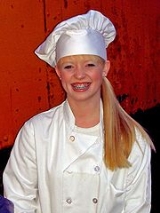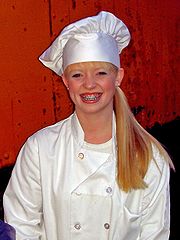
Chef's uniform
Encyclopedia

Chef
A chef is a person who cooks professionally for other people. Although over time the term has come to describe any person who cooks for a living, traditionally it refers to a highly skilled professional who is proficient in all aspects of food preparation.-Etymology:The word "chef" is borrowed ...
's uniform (or chef's whites) includes a toque
Toque
A toque is a type of hat with a narrow brim or no brim at all. They were popular from the 13th to the 16th century in Europe, especially France. Now, it is primarily known as the traditional headgear for professional cooks.- Etymology :...
(traditional hat), white double-breasted
Double-breasted
In clothing, the term double-breasted refers to a coat or jacket with wide, overlapping front flaps and two parallel columns of buttons or snaps; by contrast, a single-breasted coat has a narrow overlap and only one column of buttons. In most modern double-breasted coats, one column of buttons is...
jacket, and checkered pants. It is a common uniform in the Western world.
The double breasted jacket can be reversed to hide stains. Its thick cotton
Cotton
Cotton is a soft, fluffy staple fiber that grows in a boll, or protective capsule, around the seeds of cotton plants of the genus Gossypium. The fiber is almost pure cellulose. The botanical purpose of cotton fiber is to aid in seed dispersal....
cloth protects from the heat of stove and oven and protects from splattering of boiling liquids. Traditionally knotted cloth buttons were used because they could stand up to the frequent washing and survive contact with hot items without melting. Typically, men button to the right while women button to the left. The black and white checked pattern frequent on trousers serves to camouflage
Camouflage
Camouflage is a method of concealment that allows an otherwise visible animal, military vehicle, or other object to remain unnoticed, by blending with its environment. Examples include a leopard's spotted coat, the battledress of a modern soldier and a leaf-mimic butterfly...
minor stains. The white color of other clothing articles is intended to signify cleanliness and are often worn by highly visible head chefs. Apron
Apron
An apron is an outer protective garment that covers primarily the front of the body. It may be worn for hygienic reasons as well as in order to protect clothes from wear and tear. The apron is commonly part of the uniform of several work categories, including waitresses, nurses, and domestic...
s are used to shield the rest of the wearer's garments from food splatters and stains. The toque
Toque
A toque is a type of hat with a narrow brim or no brim at all. They were popular from the 13th to the 16th century in Europe, especially France. Now, it is primarily known as the traditional headgear for professional cooks.- Etymology :...
is a chef's hat that dates back to the 16th century when hats were common in many trades. Different heights of hats sometimes indicate rank within a kitchen. The 100 folds of the toque are said to represent the many different ways a chef knows to cook an egg. Some modern chefs have put their own distinct spin on the traditional uniform utilizing colors, patterns and design changes. Chefs may express their personal style by wearing a decorated chef's coat, some of which have food inspired prints. In more traditional restaurants, however, especially traditional French restaurants, the white chef’s coat is standard and considered part of a traditional uniform and as a practical chef's garment.
History
Chefs clothing remains a standard in the food industry. The tradition dates back to the mid-19th century. Marie-Antoine CaremeMarie-Antoine Carême
Marie Antoine Carême , known as the "King of Chefs, and the Chef of Kings" was an early practitioner and exponent of the elaborate style of cooking known as haute cuisine, the "high art" of French cooking: a grandiose style of cookery favored by both international royalty and by the newly rich of...
, a popular French chef, is credited with developing the current chef’s uniform. The tall hats had already been introduced, but Careme wanted to create a specific uniform to honor the chef. White was chosen for the chef's coat to signify cleanliness. Later, the French Master Chef Georges Auguste Escoffier encouraged his kitchen staff to wear suits outside of work to signify professionalism of chefs. Escoffier brought the traditional chef's coat to London, managing the restaurants at the Savoy Hotel
Savoy Hotel
The Savoy Hotel is a hotel located on the Strand, in the City of Westminster in central London. Built by impresario Richard D'Oyly Carte with profits from his Gilbert and Sullivan operas, the hotel opened on 6 August 1889. It was the first in the Savoy group of hotels and restaurants owned by...
and then at the Carlton Hotel.

